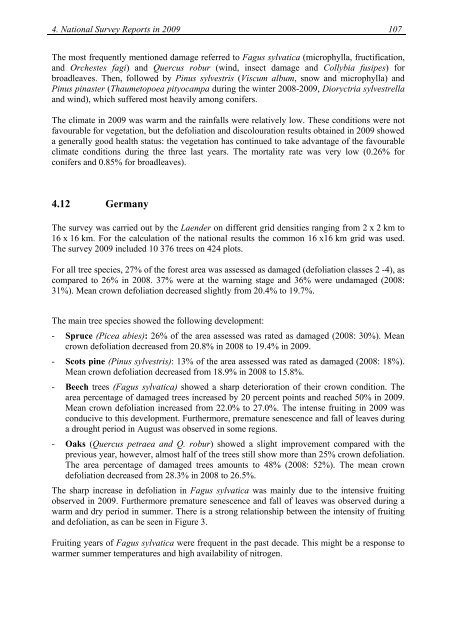Report - ICP Forests
Report - ICP Forests
Report - ICP Forests
You also want an ePaper? Increase the reach of your titles
YUMPU automatically turns print PDFs into web optimized ePapers that Google loves.
4. National Survey <strong>Report</strong>s in 2009 107<br />
The most frequently mentioned damage referred to Fagus sylvatica (microphylla, fructification,<br />
and Orchestes fagi) and Quercus robur (wind, insect damage and Collybia fusipes) for<br />
broadleaves. Then, followed by Pinus sylvestris (Viscum album, snow and microphylla) and<br />
Pinus pinaster (Thaumetopoea pityocampa during the winter 2008-2009, Dioryctria sylvestrella<br />
and wind), which suffered most heavily among conifers.<br />
The climate in 2009 was warm and the rainfalls were relatively low. These conditions were not<br />
favourable for vegetation, but the defoliation and discolouration results obtained in 2009 showed<br />
a generally good health status: the vegetation has continued to take advantage of the favourable<br />
climate conditions during the three last years. The mortality rate was very low (0.26% for<br />
conifers and 0.85% for broadleaves).<br />
4.12 Germany<br />
The survey was carried out by the Laender on different grid densities ranging from 2 x 2 km to<br />
16 x 16 km. For the calculation of the national results the common 16 x16 km grid was used.<br />
The survey 2009 included 10 376 trees on 424 plots.<br />
For all tree species, 27% of the forest area was assessed as damaged (defoliation classes 2 -4), as<br />
compared to 26% in 2008. 37% were at the warning stage and 36% were undamaged (2008:<br />
31%). Mean crown defoliation decreased slightly from 20.4% to 19.7%.<br />
The main tree species showed the following development:<br />
- Spruce (Picea abies): 26% of the area assessed was rated as damaged (2008: 30%). Mean<br />
crown defoliation decreased from 20.8% in 2008 to 19.4% in 2009.<br />
- Scots pine (Pinus sylvestris): 13% of the area assessed was rated as damaged (2008: 18%).<br />
Mean crown defoliation decreased from 18.9% in 2008 to 15.8%.<br />
- Beech trees (Fagus sylvatica) showed a sharp deterioration of their crown condition. The<br />
area percentage of damaged trees increased by 20 percent points and reached 50% in 2009.<br />
Mean crown defoliation increased from 22.0% to 27.0%. The intense fruiting in 2009 was<br />
conducive to this development. Furthermore, premature senescence and fall of leaves during<br />
a drought period in August was observed in some regions.<br />
- Oaks (Quercus petraea and Q. robur) showed a slight improvement compared with the<br />
previous year, however, almost half of the trees still show more than 25% crown defoliation.<br />
The area percentage of damaged trees amounts to 48% (2008: 52%). The mean crown<br />
defoliation decreased from 28.3% in 2008 to 26.5%.<br />
The sharp increase in defoliation in Fagus sylvatica was mainly due to the intensive fruiting<br />
observed in 2009. Furthermore premature senescence and fall of leaves was observed during a<br />
warm and dry period in summer. There is a strong relationship between the intensity of fruiting<br />
and defoliation, as can be seen in Figure 3.<br />
Fruiting years of Fagus sylvatica were frequent in the past decade. This might be a response to<br />
warmer summer temperatures and high availability of nitrogen.
















